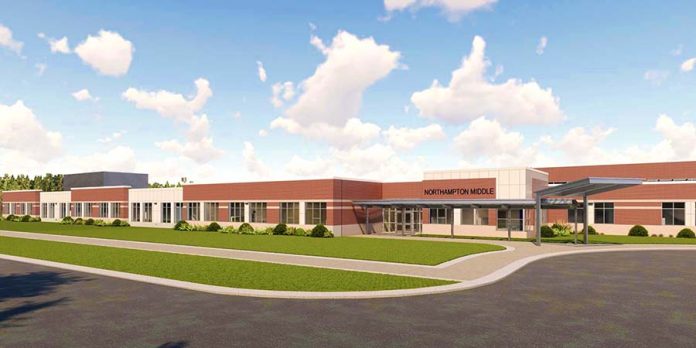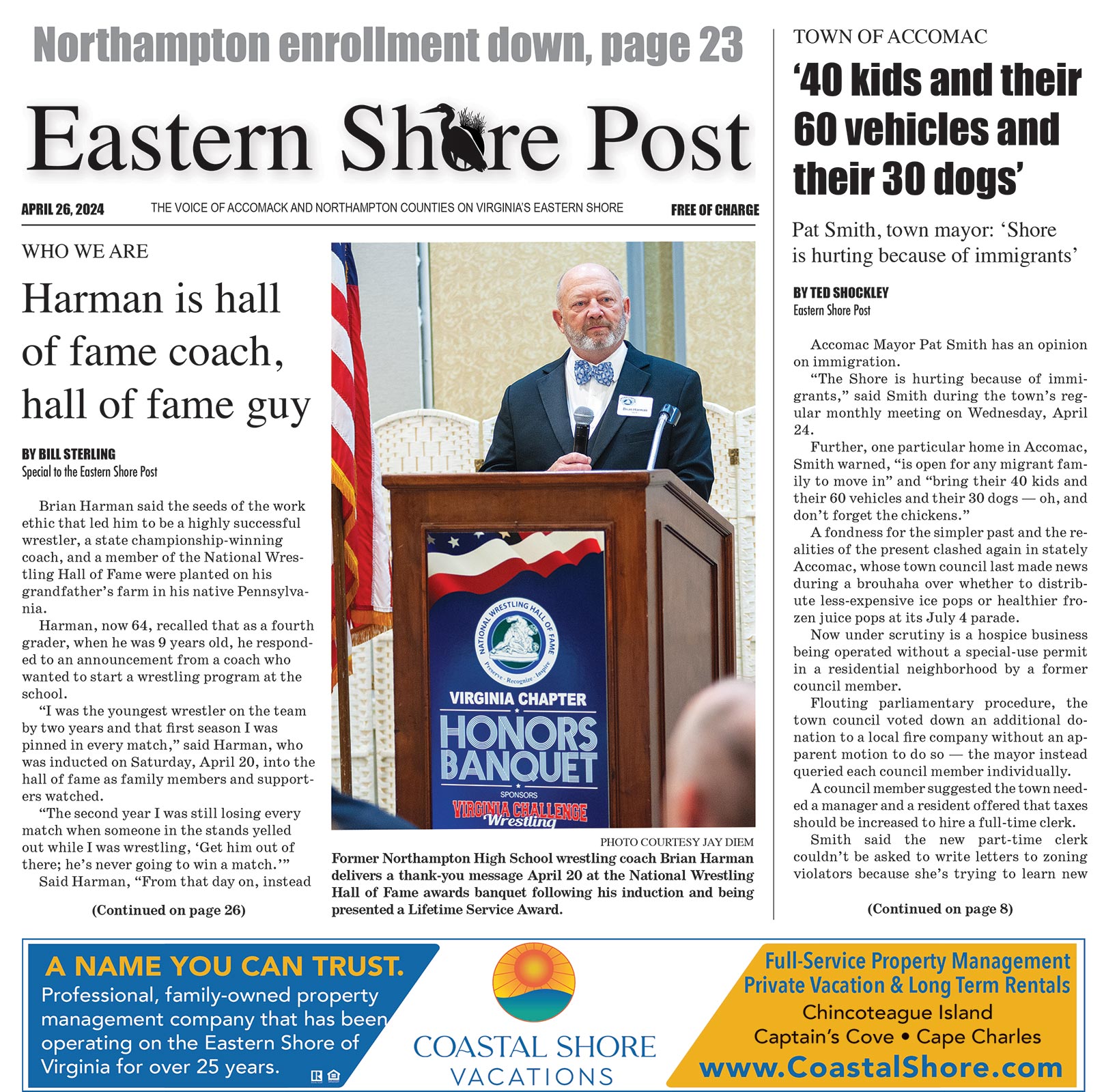
By Stefanie Jackson – Northampton supervisors voted 4-1 Tuesday night to allow contractors to bid on the Northampton middle and high school building project in spite of its new estimated cost of nearly $61.5 million, about 13% or $7 million more than the estimate provided four months ago in November 2021.
The opposing vote was made by Chair Betsy Mapp, who called the new price tag on the school project “a little crazy” and was concerned it would hinder the county from completing other projects or handling a major unexpected future expense.
The November 2021 cost estimate was for the 75% completion stage of the project design; the current cost estimate is for the 95% design completion stage. The final design documents are expected April 20.
Dane Seagle, of Skanska, the company handling construction management for the project, explained that much of the increased costs of construction were due to the COVID-19 pandemic, and the war in Ukraine also is a factor.
He presented data that showed construction costs began increasing in April 2020 – around the same time COVID-19 measures were instituted – and have “steadily inclined” into 2022.
Northampton schools Chief Financial Officer Brook Thomas said the total project cost of more than $61 million was about $52 million for construction and $9 million in “soft costs” that include engineering, construction management, and furnishings.
More than $6 million or 86% of the $7 million cost increase was unavoidable due to market fluctuations. The cost of both materials and labor have risen, Thomas noted.
The project will go to bid in April, with bids expected to be received in May and a contract to be awarded in June. Construction will take place from July 2022 to July 2024, with final completion in August 2024.
The cost of the project has increased about $23 million since architectural and engineering firm Waller, Todd & Sadler made its original estimate of approximately $38 million in October 2020.
The cost rose to more than $46 million at 45% design completion in July 2021, about $54 million at 75% design completion in November 2021, and now more than $61 million at 95% design completion.
Northampton County Finance Director John Chandler reviewed how much money has been borrowed to date for current school projects and how the money could be repaid.
Through the sale of Virginia Public School Authority (VPSA) bonds, $25 million was borrowed in 2019 and $42 million was borrowed in 2021, a total of $67 million.
However, Northampton has more than just the cost of the middle and high school project to cover – it’s also spending around $17 million on necessary improvements at Kiptopeke and Occohannock elementary schools, including energy-saving geothermal HVAC systems.
Installation was completed at Kiptopeke last summer and will be done at Occohannock this summer.
Northampton will spend more than $78.5 million on capital improvements for its four public schools, and with $67 million borrowed so far, that leaves about $11.5 million more needed.
The county must either borrow money a third time through VPSA or find alternate funding sources.
Chandler highlighted cost-savings opportunities that could reduce the amount borrowed from $11.5 million to $9.9 million.
For example, $400,000 could be saved by dealing with Skanska instead of a contractor for some parts of the project. Additionally, the Virginia General Assembly is considering giving $1.3 million in state funding to Northampton County Public Schools for school construction.
Chandler also reviewed sources of cash flow that will help pay off the school-related debt: the 1% additional sales tax implemented by the county for school capital improvements, savings from energy efficiency improvements in local public school and government buildings, and $2 million in school capital improvement funds the school division committed to pare down debt service in peak years.
Northampton currently pays about $2.6 million annually on its debts.
Chandler estimated the 1% sales tax, which will be collected for about 18 years – the term of the loan – will repay roughly half of the money borrowed through the sale of school bonds.
If Northampton decides to borrow more money through VPSA, supervisors could delay action until spring 2024, since the county already has borrowed enough to last through the majority of the two-year construction period.
There are additional opportunities to bridge the possible $11.5 million funding gap: the school division could commit $1.5 million more of its capital funds, the county could apply $1.5 million of its American Rescue Plan funding, or the county could contribute $4 million from its undesignated fund balance, its savings account.
Northampton currently has about $14 million saved, $2 million of which has been committed to its energy efficiency improvement project, leaving $12 million available. If $4 million was applied to the school projects, $8 million would remain, which County Administrator Charlie Kolakowski said would provide enough cushion for the county to absorb an emergency expenditure.
Other money-saving options include participation in a VPSA interest rebate program and obtaining additional state and federal grants.
For example, the school division is pursuing grant funding from the U.S. Department of Agriculture or USDA to cover the majority of the $425,000 cost of a commercial kitchen for the high school’s culinary arts program.
Chandler emphasized the importance of avoiding borrowing more money if possible due to its high cost. Northampton would pay $4.4 million in interest if it borrowed $11.5 million, he pointed out.
The county would pay a total of $29 million in interest on the money borrowed for all of its school projects, he added.
Kolakowski agreed that Northampton County should prioritize its schools while keeping itself out of additional debt.
But Mapp was having none of it. “I know that there are market effects here and the cost of everything is going up, but at some point we have to stop and say, ‘Isn’t this a little crazy for adding a wing onto the high school?’”
However, the project will do much more than add a wing onto the existing high school.
The whole project combines renovation and construction to transform a high school that also serves middle school students into a real high and middle school complex.
The existing Northampton High School represents two main periods of construction: 1954, when the original school was built, and 1978, when an addition was built.
Most of the 1954 construction, including the present cafeteria and auditorium, will be demolished and rebuilt elsewhere on the Northampton High School campus. Most of the 1978 addition, including the high school gym, will be renovated.
A brand-new middle school wing will be built. There will be enough space to move the sixth grade from the elementary schools to the middle school and provide sixth graders an authentic middle school experience.
Northampton Middle School will get its own gym and separate space in the new cafeteria, and the high school and middle school will share the new auditorium.
The entire campus will be modernized, incorporating contemporary design and technology to provide students an education that prepares them for higher learning experiences and careers.
“Certainly, the project we have now is not the project that was talked about originally, with the number you’re using,” Chandler told Mapp, who had expected the county to spend around $24 million.
“We had said, ‘Please economize wherever possible,’ and that hasn’t happened,” Mapp contended.
Supervisor Dixon Leatherbury said, “The question is, what number can we be happy with?” Mapp added, “What can we afford?”
She asked how many students are enrolled in Northampton schools. Average daily membership is about 1,280 students, and of that number, around 750 students would attend the new middle and high school.
Superintendent Eddie Lawrence recalled a few years ago when the school board was questioned on how much money it was spending on technology such as computers, servers, and smart boards.
“Think what would have happened during COVID if we had not done anything virtually,” he said.
Lawrence continued. “It is an awful lot of money … and believe me, in my office, I’m known as cheap. I am very conservative with money.”
“But I think we have to view this as the investment for our children and our grandchildren and the opportunities we want to give them.”
Lawrence pointed out that Northampton County “really is in a unique position. The debt’s being paid down. You’ve got basically modern buildings everywhere else that I can see.”
“This may be your last best chance to do something for education that makes a difference in your communities.”
He advised supervisors to ask themselves, “What’s the cost of doing nothing?”
According to a former school board member, about 10 or 12 years ago, Northampton could have built a brand-new middle and high school with adjoining offices for less than $30 million, Lawrence said.
What will the project cost if it’s delayed another 10 years? Lawrence asked. Furthermore, by that time, the county’s other buildings will be closer to needing further renovations.
“It’s going to cost you money one way or the other. … You’ve got to ask yourself, going forward, what type of educational facility that we’re all going to need, we’re all going to want, we’re all going to be proud of.”
Supervisor John Coker suggested a spending limit of $65 million, and if all the bids received are that much or more, “we’re done.”
He made a motion to move forward with the contractor bidding process, seconded by Supervisor Ernest Smith.
Coker said, “We owe it to our children and to our citizens, and if we want to really push economic development in Northampton County, we’d better have a nice high school, middle school.”
He said, “It’s a lot of money, but it’s something we have to do … so let’s just bite the bullet, get it done, and then, you know, we’ll figure it out just like we figure everything else out.”


